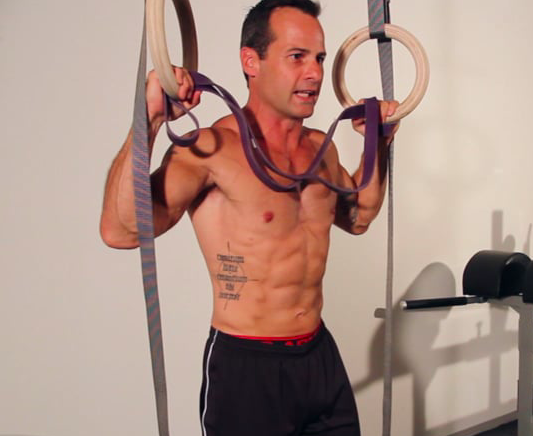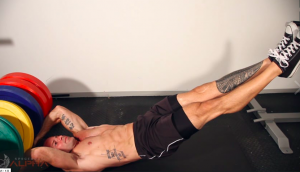
Is all that cardio helping you burn fat or is it keeping you fat?
We’ve all heard the popular advice that doing cardio (low-intensity, steady state) is the best way to burn fat. After all, low-intensity exercise uses fatty acids for energy rather than glycogen, and those fatty acids come from stored body fat. So it makes total sense that cardio—jogging, cycling, skipping rope, and all the other low-intensity workouts—are going to help you burn fat.
Well, maybe not…
A number of studies have proven that maybe aerobic training and cardio workouts are actually having the opposite effect. Too much cardio isn’t going to cause fat burning—it’s going to cause fat gain.
How the heck is this possible?
Your body basically has two sources of energy: 1) glycogen, which is derived from carbs and sugars; and 2) fatty acids.
When you first start your workout, be it a resistance training session or a run, your body starts off by burning the glycogen (around 100 calories) present in your bloodstream. It will keep burning that until it runs out, then it will start looking around for other sources of energy.
If your exercise is high intensity (anaerobic), there isn’t enough oxygen available to burn fatty acids, so it taps into your glycogen stores. If your exercise is low-intensity (aerobic), there is more than enough oxygen available, so your body can burn fatty acids—the fatty acids stored in your adipose tissue. This is why jogging and other aerobic exercises are believed to be so good for fat burning.
The problem is that your body is an adaptive machine! It’s designed to adapt to the demands placed on it by your daily activity.
When you exercise a lot, your body tries to adapt to meet those demands. Fat is stored for emergency (starvation) situations, not necessarily intended to be available to burn during exercise. Thus, your body tries to adapt to burning more glycogen rather than tapping into those vital fatty acids.
If you’re doing only cardio training, your body will catabolize (break down) any energy-storing tissue it can. Seeing as it’s trying to avoid burning the fat it’s designed to store, it relies on the other source of energy: glycogen, which is stored in muscle tissue.
The result is muscle tissue breakdown (catabolism). Your body literally breaks down muscle tissue in order to feed your daily exercise. As a result, you keep storing body fat while losing muscle mass.
Human growth hormone, or HGH, is critical for muscle growth, particularly lean muscle mass. When HGH levels are at their peak (during the teenaged/young adult years), muscle growth is much easier. As we age, HGH levels naturally start to decline, which is why it’s much harder to build muscle as we get older.
But low-intensity exercise can actually suppress the production of HGH. Or, at the very least, it allows the continued decline of those hormone levels, meaning we have less and less of it available in our bodies with every passing year.
Studies have proven that prolonged periods of low-intensity exercise can have a suppressive effect on a number of important hormones, particularly the T3 thyroid hormone. T3 is responsible for a number of functions in the body, but its main function in regards to fitness is fat loss. When the T3 hormone is being produced in proper quantities, it will encourage better activation and utilization of body fat.
But not when you do too much aerobic training!
Prolonged periods of exercise (common among low-intensity cardio) can slow down your thyroid gland’s output of the T3 hormone. This will lead to less effective fat-burning. Compounded with the effects of decreased muscle mass and lower HGH levels, and you’ll start to notice very serious effects.Fat Burning exercises
Cortisol is the hormone produced by your body during times of stress. In small doses (such as in an emergency situation), it can encourage faster body function (courtesy of the adrenaline it works with).
But chronically high cortisol levels are a different matter. High cortisol levels will actually cause your body to store fat, particularly the visceral fat located around your belly.
Now, pair that increased fat storage with a decrease in muscle mass and less effective fat-burning, and you’ve got a real problem on your hands. All that cardio is actually having the opposite of the desired effect—it’s packing on the pounds of fat rather than burning them!
So what’s the key to effective weight loss? If cardio isn’t the answer, what should you be doing? Can you lose weight by resistance training alone? If not, what’s the solution?
The good news is that there are two simple solutions to guarantee effective fat-burning in your daily workouts:
Combine cardio with resistance training. Lifting weights signals to your body that the muscle mass is critical, so it basically helps to protect the muscles when doing cardio. Always start your workout with your weight training, and keep pumping until you’ve burned through those 500(ish) calories of stored glycogen. Once you finish your resistance training and hit the cardio session, you’ll be burning all fat! And, because your muscles are protected, your body will have no choice but to activate stored fat for energy. The result: better fat loss!
Increase the intensity, shorten the length. It’s long periods of low-intensity exercise that cause the above-mentioned negative effect. All you have to do to combat that is raise the intensity of the training session and spend less time exercising. High-Intensity Interval Training, like the Alpha System, is a beautiful option thanks to the fact that it does BOTH. Your body will burn primarily glycogen during the periods of high intensity, but it will get into some fat-burning during the low-intensity intervals. However, the fat-burning will continue for hours after you finish working out thanks to the fact that HIIT kicks your metabolism into high gear.
Do either one of these two things, and you’ll prevent the negative effects of aerobic training and keep your body burning fat rather than protecting it! Learn more about the ideal workout for Christian patriots, preppers and survivalists here.




